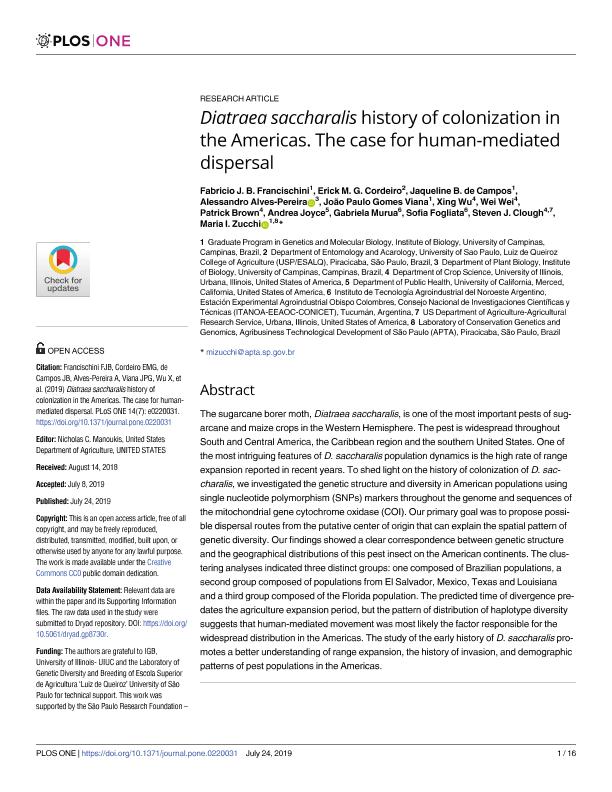Mostrar el registro sencillo del ítem
dc.contributor.author
Francischini, Fabricio J. B.
dc.contributor.author
Cordeiro, Erick M. G.
dc.contributor.author
Campos, Jaqueline B. de
dc.contributor.author
Alves Pereira, Alessandro

dc.contributor.author
Gomes Viana, João Paulo
dc.contributor.author
Wu, Xing
dc.contributor.author
Wei, Wei

dc.contributor.author
Brown, Patrick
dc.contributor.author
Joyce, Andrea
dc.contributor.author
Murúa, María Gabriela

dc.contributor.author
Fogliata, Sofia Victoria

dc.contributor.author
Clough, Steven J.
dc.contributor.author
Zucchi, María Inmaculada

dc.date.available
2021-01-06T21:00:42Z
dc.date.issued
2019-07
dc.identifier.citation
Francischini, Fabricio J. B.; Cordeiro, Erick M. G.; Campos, Jaqueline B. de; Alves Pereira, Alessandro; Gomes Viana, João Paulo; et al.; Diatraea saccharalis history of colonization in the Americas: The case for human-mediated dispersal; Public Library of Science; Plos One; 14; 7; 7-2019; 1-16
dc.identifier.issn
1932-6203
dc.identifier.uri
http://hdl.handle.net/11336/121682
dc.description.abstract
The sugarcane borer moth, Diatraea saccharalis, is one of the most important pests of sugarcane and maize crops in the Western Hemisphere. The pest is widespread throughout South and Central America, the Caribbean region and the southern United States. One of the most intriguing features of D. saccharalis population dynamics is the high rate of range expansion reported in recent years. To shed light on the history of colonization of D. saccharalis, we investigated the genetic structure and diversity in American populations using single nucleotide polymorphism (SNPs) markers throughout the genome and sequences of the mitochondrial gene cytochrome oxidase (COI). Our primary goal was to propose possible dispersal routes from the putative center of origin that can explain the spatial pattern of genetic diversity. Our findings showed a clear correspondence between genetic structure and the geographical distributions of this pest insect on the American continents. The clustering analyses indicated three distinct groups: one composed of Brazilian populations, a second group composed of populations from El Salvador, Mexico, Texas and Louisiana and a third group composed of the Florida population. The predicted time of divergence predates the agriculture expansion period, but the pattern of distribution of haplotype diversity suggests that human-mediated movement was most likely the factor responsible for the widespread distribution in the Americas. The study of the early history of D. saccharalis promotes a better understanding of range expansion, the history of invasion, and demographic patterns of pest populations in the Americas.
dc.format
application/pdf
dc.language.iso
eng
dc.publisher
Public Library of Science

dc.rights
info:eu-repo/semantics/openAccess
dc.rights.uri
https://creativecommons.org/licenses/by/2.5/ar/
dc.subject
SUGARCANE BORE
dc.subject.classification
Zoología, Ornitología, Entomología, Etología

dc.subject.classification
Ciencias Biológicas

dc.subject.classification
CIENCIAS NATURALES Y EXACTAS

dc.title
Diatraea saccharalis history of colonization in the Americas: The case for human-mediated dispersal
dc.type
info:eu-repo/semantics/article
dc.type
info:ar-repo/semantics/artículo
dc.type
info:eu-repo/semantics/publishedVersion
dc.date.updated
2020-11-16T20:01:31Z
dc.journal.volume
14
dc.journal.number
7
dc.journal.pagination
1-16
dc.journal.pais
Estados Unidos

dc.journal.ciudad
San Francisco
dc.description.fil
Fil: Francischini, Fabricio J. B.. Universidade Estadual de Campinas. Instituto de Biología; Brasil
dc.description.fil
Fil: Cordeiro, Erick M. G.. Universidade do Sao Paulo. Escola Superior de Agricultura Luiz de Queiroz; Brasil
dc.description.fil
Fil: Campos, Jaqueline B. de. Universidade Estadual de Campinas. Instituto de Biología; Brasil
dc.description.fil
Fil: Alves Pereira, Alessandro. Universidade Estadual de Campinas; Brasil
dc.description.fil
Fil: Gomes Viana, João Paulo. Universidade Estadual de Campinas. Instituto de Biología; Brasil
dc.description.fil
Fil: Wu, Xing. University of Illinois; Estados Unidos
dc.description.fil
Fil: Wei, Wei. University of Illinois; Estados Unidos
dc.description.fil
Fil: Brown, Patrick. University of Illinois; Estados Unidos
dc.description.fil
Fil: Joyce, Andrea. University of California; Estados Unidos
dc.description.fil
Fil: Murúa, María Gabriela. Consejo Nacional de Investigaciones Científicas y Técnicas. Centro Científico Tecnológico Conicet - Tucumán. Instituto de Tecnología Agroindustrial del Noroeste Argentino. Provincia de Tucumán. Ministerio de Desarrollo Productivo. Estación Experimental Agroindustrial "Obispo Colombres" (p). Instituto de Tecnología Agroindustrial del Noroeste Argentino; Argentina
dc.description.fil
Fil: Fogliata, Sofia Victoria. Consejo Nacional de Investigaciones Científicas y Técnicas. Centro Científico Tecnológico Conicet - Tucumán. Instituto de Tecnología Agroindustrial del Noroeste Argentino. Provincia de Tucumán. Ministerio de Desarrollo Productivo. Estación Experimental Agroindustrial "Obispo Colombres" (p). Instituto de Tecnología Agroindustrial del Noroeste Argentino; Argentina
dc.description.fil
Fil: Clough, Steven J.. University of Illinois; Estados Unidos. United States Department of Agriculture; Estados Unidos
dc.description.fil
Fil: Zucchi, María Inmaculada. Universidade Estadual de Campinas; Brasil
dc.journal.title
Plos One

dc.relation.alternativeid
info:eu-repo/semantics/altIdentifier/doi/http://dx.doi.org/10.1371/journal.pone.0220031
dc.relation.alternativeid
info:eu-repo/semantics/altIdentifier/url/https://journals.plos.org/plosone/article?id=10.1371/journal.pone.0220031
Archivos asociados
